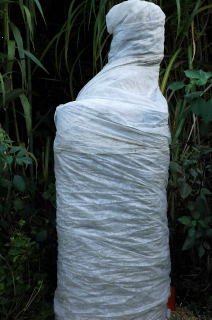There is a trend these days to plant trees, shrubs, and flowers that remind us of either 'the Old Country' or our recent vacation in the tropics. Some of these plants will survive (emphasis on SURVIVE!) our basic BC / Lower Mainland winter relatively untouched. Most, however, need a lot of work (emphasis on LOT!).
Do I need to protect?
So you have an exotic palm, banana or other tree that is giving that lush tropical look to your garden and now the weather has turned to a typical Pacific Northwest autumn and winter. These plants are grown near the limit of their hardiness and need a little bit of care to survive the changeable seasons. Generally, tree ferns are relatively easy to protect compared to other plants commonly grown near the limit of their hardiness, such as palms.
You should plan on protecting your exotic from cold, if temperatures are expected to fall below the limit of its cold-hardiness. A sheltered micro-climate may enable you to get away with growing more tender exotics with less protection, while an exposed situation may require more protection than you would expect. There are a variety of different protection methods. Many of them will guarantee that you get funny looks from the neighbours, but that will be worth it when you have a tree fern or banana and they don't.
When should I protect?
The simple method - the first approach is to protect the exotic for the entire winter. That means you would take whatever protection you are planning before the cold comes (say, in November) and leave the exotic under this protection until the danger of cold is over the following spring (say, March or April). This way you do not have to watch the weather forecasts, being constantly concerned about impending cold weather on the way, because the exotic is safe and sound all winter. This technique can generally be recommended for climates that consistently have long periods of cold weather every winter, but it works in our area too!
Plants that may need protection in a NORMAL BC winter
Usual ruling: if you think of it being from Morocco or any of your favourite tropical areas, it should be protected. Tropicals grown in the Lower Mainland / Southern Vancouver Island regions include Windmill Palms (Trachycarpus fortunei), Hardy Bananas (Musa Basjoo, Musa Sikkimensis), New Zealand Flax (Phormium), Hardy Tree Ferns (Dicksonia antarctica), Large Leaf Hebes, Bougainvillea, Trumpet Vine (Campsis radicans), Brugmansias and Daturas, Citrus, and Olives to name a few.
The physics of water
Water is the universal standard upon which almost all things are measured. Weight for example 1L of water = 1 kg. Water has a high specific heat so that means it takes a lot of energy to heat it up to boiling. It also needs to lose a lot of energy to cool it down, hence the large compressors on our fridges and freezers. USE THIS TO YOUR ADVANTAGE: heavy snow makes a great insulator. Pile it on top of your pots and plants and it will insulate against fluctuations in temperature.
The best solution for overr-wintering container plants
Plants are always better off in the ground during winter in freezing climates. If at all possible, find a spot in your garden to either dig in the plants temporarily for the winter, or bury them pot and all. Mulch with 2-4 inches of bark or leaves, once the soil has frozen. If you must leave your plants in containters, you'll need to provide some extra protection.
Things to consider before deciding to overwinter your container plants
In general, plants can survive in containers if they are rated as 2 USDA Hardiness zones lower than the zone you are gardening in. So if you are in Zone 5, you'd be safe with plants labelled hardy to Zone 3, but how many of them are there? Gardeners in Zone 7 and 8, on the other hand, can get by with minimal loss on chilly nights if they stick to the much wider variety of plants considered Zone 5 hardy. Another thing to consider is, once the ground freezes under the container, water cannot escape the bottom of the pot. The container will thaw before the ground does and, if you get a few rainy days, the water will stand in the pot - either rotting the roots or turning into an ice cube when the weather chills again. Avoid this by tilting the pots slightly, or raising the container off the ground a few inches with bricks or planter feet.
Protection for potted plants left outdoors in winter
Some tips to give your container plants a bit of an advantage in making it through the winter include:
- The more soil in the pot, the better insulated the roots will be. If possible, simply slip the existing container into a larger container and fill the sides with soil or mulch.
- Cluster several containers together and move them to a sheltered spot, such as near the hourse or a south-facing wall.
A good (but some would say misguided) reference to hardy exotics is Palms Won't Grow Here and Other Myths: Warm-Climate Plants for Cooler Areas by David A. Francko.
Author: Dr. Alan Reid, Instructor Department of Biology, The University of the Fraser Valley







